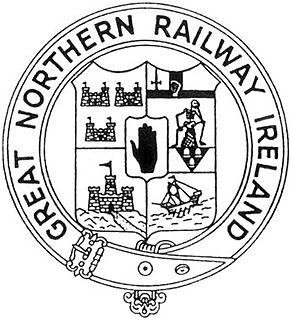Trams in India were established in the late-19th century. Horse-drawn trams were introduced in Kolkata in 1873; electric trams began in Chennai in 1895, and trams were also introduced in Mumbai, Baroda, Nashik, Kanpur, Kochi, Patna and Bhavnagar. They were discontinued in all Indian cities between 1930 and 1970, except for Kolkata.

The Howth Tram was a tram which served Howth Head, near Dublin, Ireland. The termini were at Sutton railway station and Howth railway station. It operated from June 1901 to 31 May 1959 and was run by the Great Northern Railway (Ireland), which viewed it as a way to bring more customers to its railway stations at Sutton and Howth.

Nottingham and District Tramways Company Limited was a tramway operator from 1875 to 1897 based in Nottingham in the United Kingdom.
Dick, Kerr and Company was a locomotive and tramcar manufacturer based in Kilmarnock, Scotland and Preston, England.
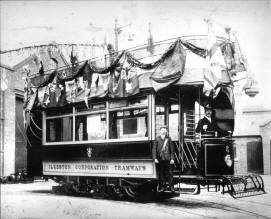
Ilkeston Corporation Tramways was a tramway network in Ilkeston, Derbyshire, in the East Midlands of England run firstly by Ilkeston Borough Council and from 1916 by the Nottinghamshire and Derbyshire Tramways Company. The system ran between 1903 and 1931. Ilkeston was the first town in Derbyshire to adopt and operate a fully electrical tramway system.

The Strasbourg tramway, run by the CTS, is a network of six tramlines, A, B, C, D, E and F that operate in the city of Strasbourg in Alsace, France, and Kehl in Baden-Württemberg, Germany. The first tramline in Strasbourg, which was originally horse-drawn, opened in 1878. After 1894, when an electric powered tram system was introduced, a widespread network of tramways was built, including several longer distance lines on both sides of the Rhine. The decline of the tramways system began in the 1930s, and ended with the retirement of the service in 1960 in parallel to the closure of many such systems in France and the rest of the Western world. However, a strategic reconsideration of the city's public transport requirements led to the reconstruction of the system, a development whose success led to other large French cities reopening their tramways, such as Montpellier and Nice. Lines A and D were opened in 1994, lines B and C were opened in 2000, line E was opened in 2007 and line F was opened in 2010. It is regarded as a remarkable example of the tramway's rebirth in the 1990s. Together with the success seen in Nantes since 1985, the Strasbourg experiment resulted in the construction of tramways in multiple other French urban areas, and the expansion of tramway systems remains an ongoing project in Strasbourg and throughout France.

The Clogher Valley Railway was a 37-mile-long (60 km), 3 ft narrow gauge railway in County Tyrone and County Fermanagh, Northern Ireland. It opened in May 1887 and closed on 1 January 1942.
Ulster railways, present and past, include:

Dublin tramways was a system of trams in Dublin, Ireland which commenced line-laying in 1871, and began service in 1872, following trials in the mid-1860s. Established by a number of companies, the majority of the system was eventually operated by forms of the Dublin United Tramways Company (DUTC), dominated for many years by William Martin Murphy. Most of the services ran within the city centre and near suburbs, with the majority of major suburbs served. Additionally, there were two longer-range services, one reaching the "excursion" destination of Poulaphouca Falls, and two services concerning Howth.
Dover Corporation Tramways was the operator of the second tramway system built in the United Kingdom. It was in operation from 1897 to 1936. The worst ever tram accident in the United Kingdom occurred on the system in 1917.

Trams in Ballarat were first used for public transport in 1887. They ceased to operate as a means of public transport in 1971, but a section continues to be operated today as a tourist attraction.
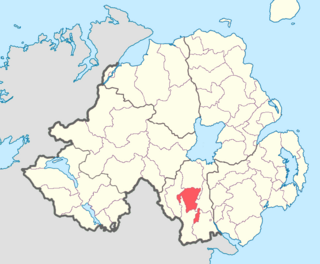
Fews Lower is a barony in County Armagh, Northern Ireland. Its lies in the center of the county, with an enclave lying just to the south-east. The main portion is bordered by four other baronies: Armagh to the west; Oneilland West to the north; Orior Lower to the east; and Fews Upper to the south. Fews Upper and Orior Lower also border the enclave to its north and west, with Orior Upper to its south-west. The Fews Mountains run through both Fews Lower and Upper, the highest peak of which in Fews Lower is, Deadman's Hill, which stands at 1,178 ft. Fews Lower and Upper formed the barony of The Fews until it was sub-divided.

The Weston-super-Mare Tramways were the electric street tramways of the seaside resort of Weston-super-Mare in Somerset, England. It operated a fleet of up to 16 standard gauge single- and double-deck tramcars on routes totalling 2.92 miles (4.70 km) to Birnbeck Pier, The Sanatorium and Locking Road. It opened in 1902 and was replaced by bus services in 1937.

The City of Derry Tramways was a tramway in Derry, Ireland that operated from 1897 until 1919. This was a standard gauge line served by horse trams and was never electrified.

The Cavehill and Whitewell Tramway operated steam powered, then horse drawn and finally electric tramway services between Cavehill and Whitewell in Belfast, Ireland between 1882 and 1911. It was subsumed into Belfast Corporation Tramways.

The 3 ft narrow gauge Portstewart Tramway operated tramway services between Portstewart and Portstewart railway station at Cromore from 1882 to 1926.
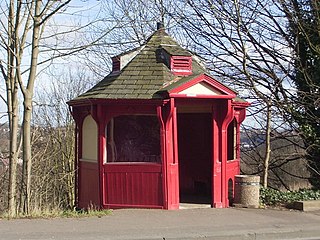
Huddersfield Corporation Tramways operated a tramway service in Huddersfield, England, between 1883 and 1940. It initially used steam locomotives pulling unpowered tramcars, but as the system was expanded, a decision was taken to change to electric traction in 1900, and the first electric trams began operating in February 1901. The system was built to the unusual gauge of 4 ft 7 3⁄4 in, in the hope that coal wagon from neighbouring coal tramways, which used that gauge, could be moved around the system. This did not occur, but two coal trams were used to delivered coal to three mills.
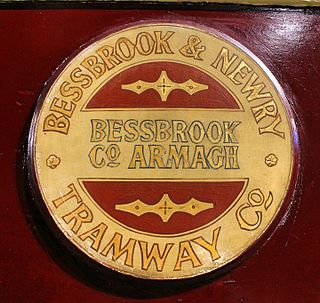
The Bessbrook and Newry Tramway operated a 3 ft narrow gauge, hydro-electrically powered tramway transporting passengers and freight between Bessbrook and Newry in Northern Ireland between 1885 and 1948.
Rockhampton Council Tramways was a steam tram service which was operated by Rockhampton City Council from 1909 until 1939 in the Central Queensland city of Rockhampton, the only regional city in Queensland to have had a tram service. The line has since been rebuilt and is operated as a tourist attraction by the Archer Park Rail Museum.


